 |
|
USSR's Nuclear Weapon Program
The Soviet nuclear weapons program was officially initiated in April 1942, when Soviet Premier Joseph
Stalin received a letter from nuclear physicist Georgy Flyorov about the lack of published physics
journeys by the US, UK, and Germany on nuclear fission. The letter also pointed out the lack of
published papers on the subject by prominent Western nuclear physicists since the discovery of nuclear
fission in 1939. This lack of activity became suspicious to the Soviet leadership, and as a result the
Soviet Union began research of nuclear fission for military purposes.
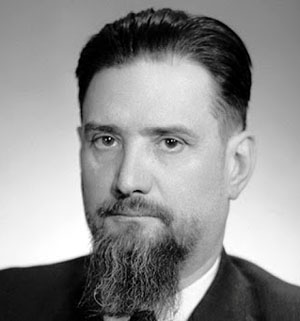
Igor Vasilyevich Kurchatov
|
In 1941, a year before Stalin initiated the nuclear weapon program, a Soviet spy named Vladimir
Barkovski obtained a copy of the MAUD Report, a top secret summary of the U.K.'s plans to build atomic
weapons, as well as parallel efforts conducted in the United States. Barkovski obtained the report from
an operative working at the Soviet Embassy in London. However, this valuable resource was ignored by the
Soviet leadership, no steps were taken, and the document was virtually forgotten about.
A large scale research effort could not be conducted due to the ongoing Great Patriotic War. Despite
this, Lavrentiy Beria was appointed as the administrative leader of the project, and physicist Igor
Kurchatov was appointed as head of scientific research. One of the first steps taken by Kurchatov was to
recruit his friend and colleague Yuli Khariton, a physicist that studied at Cambridge. The entire
project at that time was crowded into a small laboratory in Moscow, named Laboratory No. 2. Kurchatov
was only able to recruit 5 scientists to work on the project in its early stages. As research
progressed, the project was given a new underground laboratory on the outskirts of Moscow. The entrance
to the laboratory was covered by a large tent, the entire complex was surrounded by barbed wire fence
and heavily guarded by the Soviet military.
Since the conception of the project, thousands of stolen documents were pouring into the hands of Soviet
intelligent courtesy of Communist sympathizing spies working in England and the United States. The most
famous atomic spy was Klaus Fuchs, who worked as a nuclear physicist in Britain's atomic bomb project.
Through a contact called 'Red Sonja', he passed on vast amounts of information to the Soviet Union.
Stalin had learned about the U.S. Manhattan Project from a telegram sent by a Soviet Spy working in the
United States in 1943. This steady supply of information helped the Soviet nuclear weapons project make
up valuable time lost due to a low budget, lack of resources, and lack of scientists.
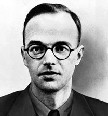
Klaus Emil Julius Fuchs
|
Kurchatov was giving the task of interpreting the vast amounts of information gathered by spies working
in the Manhattan project. Despite the thousands of papers stored at the secret Soviet archives, Beria
only allowed Kurchatov access to them in an effort to hide how dependent Soviet research was on the
stolen documents.
During this time, the United States and Great Britain joined efforts in nuclear weapons research.
Britain's scientists went to Los Alamos to work in the Manhattan Project. This was an important event
for the Soviet project because they now would have a spy, Klaus Fuchs, working at Los Alamos. Up until
this time, the details of the Manhattan Project were unknown to Kurchatov and his team. The information
they did have about it was gathered from various Universities around the United States such as Berkley,
Yale, and Princeton.
With Fuchs's access to Los Alamos, the spy operation was stepped up. At one point information was
falling into the hands of the Soviets faster then it reached some of the scientists at Los Alamos. A
Soviet agent known to the FBI as Anatoli Yakovlev coordinated the large web of spies working in the
United States through the Soviet consulate in New York City. This network of spying was called
“Operation Enormous” and would become one of the most successful espionage efforts in history.
On July 16, 1945, the United States detonated the first atomic bomb in the New Mexico desert, code named
Trinity. The following day, President Truman told Stalin about a new 'super weapon' possessed by the
United States; Stalin's reaction was indifferent. A month later, two atomic bombs were dropped on Japan,
bringing an end to World War 2.
The news of the atomic bombings of Japan shocked and enraged Stalin. Despite knowing about the Manhattan
Project, he was still appalled at the damage caused by the weapons and that the United States actually
would use such a weapon. Shortly after, Stalin issued an ultimatum to Beria, ordering an atomic bomb to
be built within 5 years.
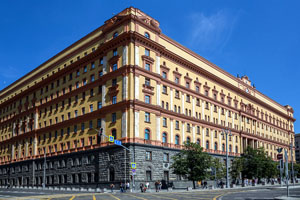
The Lubyanka - KGB Headquarters
|
A special department was set up at the People's Commissariat for Internal Affairs , called “Department
S” (also known as Bureau #2). The purpose of “Department S” was to consolidate the research efforts and
organize the 10,000 documents gathered about America's atomic bomb project. Another objective assigned
to “Department S” was to find scientists able to assist Kurchatov in interpreting the stolen documents
held in the vaults at Moscow. The NKVD was put in charge of the recruiting. Two young scientists were
chosen to assist Kurchatov, Arkady Rylov and Yakov Torletsky.
One of the most important documents obtained was a detailed diagram of the Trinity implosion device,
stolen from Los Alamos by Klaus Fuchs. This diagram was obtained by Fuchs in July 1945, where he passed
it on to one of his contacts working for “Operation Enormous”.
Work proceeded at a frantic pace, with the scientists working around the clock with very few breaks.
Scientists worked closely with translators as the thousands of documents needed to be translated into
Russian from English. These documents were passed on under strict security protocols. Transfers would be
supervised closely by military guards and armed NKVD agents. Other then the few people with access to
the vaults containing the stolen documents, no one within the project knew their actual source. Under
Beria's instructions, the Scientists were lead to believe the documents came from rival teams working
elsewhere.
The project scientists later acquired a book titled “Atomic Energy for Military Purposes” written by
Henry Smyth and published in the West. The book was given to the Soviet scientists courtesy of Niels
Bohr, a famous nuclear theoretician and advocate of open exchanges and nuclear cooperation between the
United States and Soviet Union. The purpose of the book was to define what was public and what was
secret about the atomic bomb program, to give the scientists at Los Alamos a clear idea of what could be
discussed freely. Despite opposition from Great Britain, President Truman gave permission for the book
to be published. This book gave the Soviet team a large boost needed after hitting several developmental
walls. While the book did not necessarily reveal crucial data about the design of an atomic bomb, it
provided the Soviet scientists good data about design elements not worth pursuing.
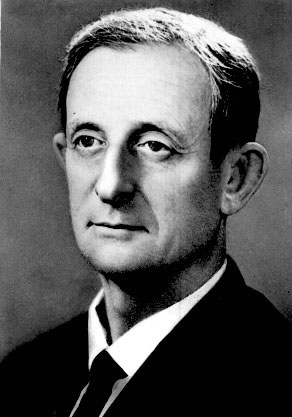
Yulii Khariton
|
A few months after the Niels Bohr incident, Yuli Khariton was put in charge of finding a suitable
location for conducting advanced nuclear research. The town of Sarov, located in Nizhny Novgorod Oblast
in Russia, was chosen as the home for Design Bureau No. 11 (KB-11). Over the next few years, an entire
town devoted to nuclear weapons research was established called Arzamas-16. Built by thousands of
prisoners from Siberia Gulags, this was one of the mos secret cities in the Soviet Union. The city was
closed off to all outsiders, only authorized personnel were allowed access, and all work conducted
inside the city was directed for nuclear weapon research.
Beria created a climate of fear within the city. Everyone working in the city was under constant
surveillance at all times, even the top scientists. The head of one of the departments at Arzamas-16 was
sentenced to 8 years in prison for reportedly boasting to his family about the work being conducted in
the city. Another worker committed suicide after misplacing several papers, choosing to avoid State
punishment.
Yuli Khariton later wrote about Beria; “Beria quickly heartened all work on the project with necessary
scope and dynamism. This man, who impersonated evil in the country's modern history, possessed at the
same time tremendous vigor and efficiency... It was impossible not to admit his intellect, willpower,
and purposefulness. He was a first class manager, who was able to bring every job to its conclusion”.
At the time, no Uranium deposits were known in Russia. The developmental team got a break after hearing
rumors about large quantities of Uranium being stored near the American zone in East German, left there
by the Nazis during World War 2. Uranium was found in an abandoned factory near the border and was
quickly snatched by the Soviets. The United States was unaware of the presence of this Uranium. This
discovery saved at least a year of developmental work.
The first Soviet reactor went critical on Christmas Day 1946 at 6:01 PM local time at the Kurchatov
Institute in Moscow. The Uranium confiscated from Eastern Germany was used for the reactor, which was
called F-1. Beria was on hand for the first start up of the reactor. Soon after additional Uranium
deposits were discovered in Czechoslovakia.
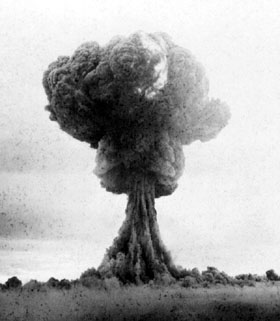
Joe-1 29/08/1949
|
Two years after Stalin's ultimatum, a full scale nuclear reactor was built in the Urals, Chelyabinsk-40.
This reactor would make the plutonium which would be used for the first Soviet atomic nuclear bomb as
well as hundreds of other weapons that would be produced later on. The reactor went critical one year
and eight months after construction first began. The plutonium went into an atomic device design by
Khariton, it was an exact copy of the U.S. Trinity “Gadget”.
In 1949, three trains left Arzamas-16 bound for Semipalatinsk in the Republic of Kazakhstan. One train
had scientists and members of the politburo, the other train carried soldiers, and the third train
contained the Soviet Union's first atomic device. Located in the isolated steppes of eastern Kazakhstan,
the test site was chosen by Beria in 1947.
At 7:00 AM local time, on August 29, 1949, the Soviet Union successfully detonated a nuclear bomb. The
test was called First Lightning by the Soviets and referred to as Joe-1 in the United States. It had
come as a complete shock to the West, which had not predicted the Soviet Union building an atomic bomb
in such little time. The reason the United States was caught off guard was because its intelligence
sources were unaware of the uranium deposits discovered by Soviet scientists in Eastern Germany and in
Czechoslovakia. General Leslie R. Groves, former head of the Manhattan Project, testified before the
U.S. Senate several years before that the Soviet Union had no uranium at all, when in reality a working
nuclear reactor was on line in Moscow. The Joe-1 atomic device, which had a yield of 22 kilotons, would
later be weaponized in the Soviet Union's first nuclear weapon, RDS-1.
Nuclear Testing
The Soviet Union conducted a nuclear testing series second to only that of the United States' in terms
of size, length, and scope. For over 40 years the Soviet Union had conducted 718 nuclear tests,
involving 969 detonations. 213 of these tests were conducted in the atmosphere, mostly at the test sites
in present day Kazakhstan and at the Norther Test Site Novaya Zemlya.
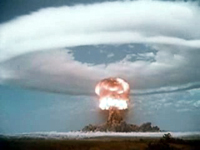 The slow pace of the Soviet nuclear weapons program following the Joe-1 test was a great contrast to the
accelerated nature it was conducted under prior to that test. The program was geared toward developing a
single nuclear device in the quickest time possible and little effort was put into engineering the
program to remain efficient and productive in the long run. Two years were needed following the Joe-1
test to ensure the program became a productive weapons industry. By the time the program got back on its
feet the United States had already begun thermonuclear experiments in the Pacific, which culminated in
the Ivy Mike shot in 1952.
The slow pace of the Soviet nuclear weapons program following the Joe-1 test was a great contrast to the
accelerated nature it was conducted under prior to that test. The program was geared toward developing a
single nuclear device in the quickest time possible and little effort was put into engineering the
program to remain efficient and productive in the long run. Two years were needed following the Joe-1
test to ensure the program became a productive weapons industry. By the time the program got back on its
feet the United States had already begun thermonuclear experiments in the Pacific, which culminated in
the Ivy Mike shot in 1952.
Soviet scientists had been researching thermonuclear capabilities since the late 1940s, but were not
allowed to pursue them during that time. The successful detonation of a hydrogen bomb by the United
States spurred thermonuclear research in the Soviet Union, which conducted its first thermonuclear test
in 1953. In 1955, the Soviet Union successfully airdropped a two-stage hydrogen bomb and acquired a
short lived monopoly on thermonuclear weapons.
It was also during this time that a new nuclear weapons research facility was founded at Chelyabinsk-70.
The creation of this new research facility was a result of the rapid expansion undergoing in the Soviet
nuclear weapons program. Approximately 1/3 of Arzamas-16's staff was moved to this new facility which
was referred to as Scientific Research Institute 1011. The primary goals of Chelyabinsk-70 was to
develop gravity bombs and all SLBMs, as well as low-fission nuclear devices to be used for peaceful
purposes. In the 1960s, the main function of the facility was the miniaturization of nuclear warheads.
|
|
|
 |





